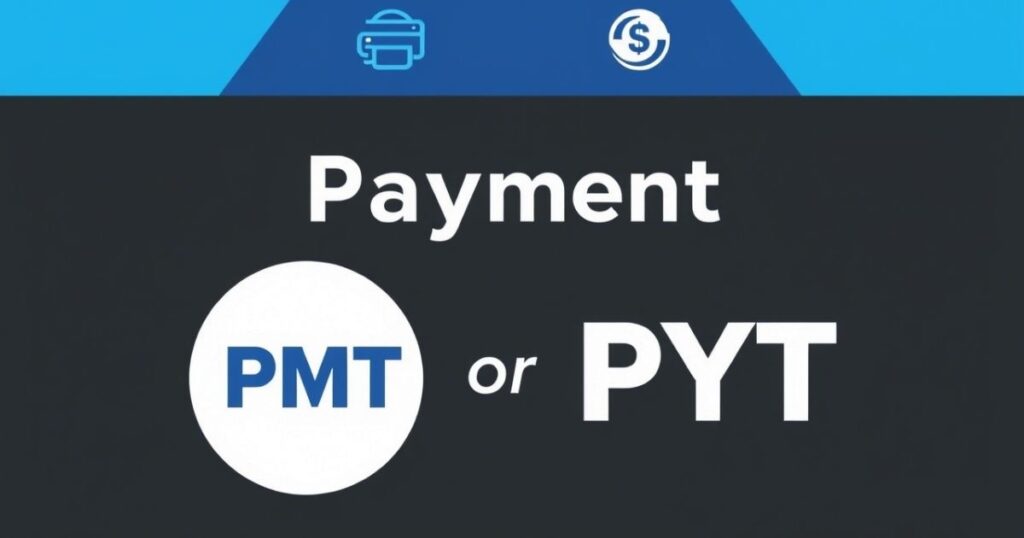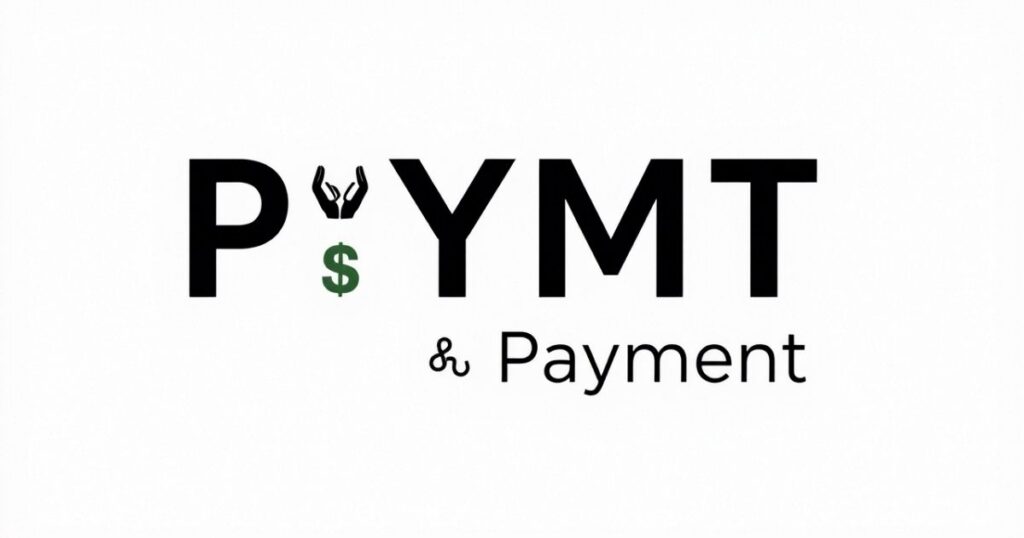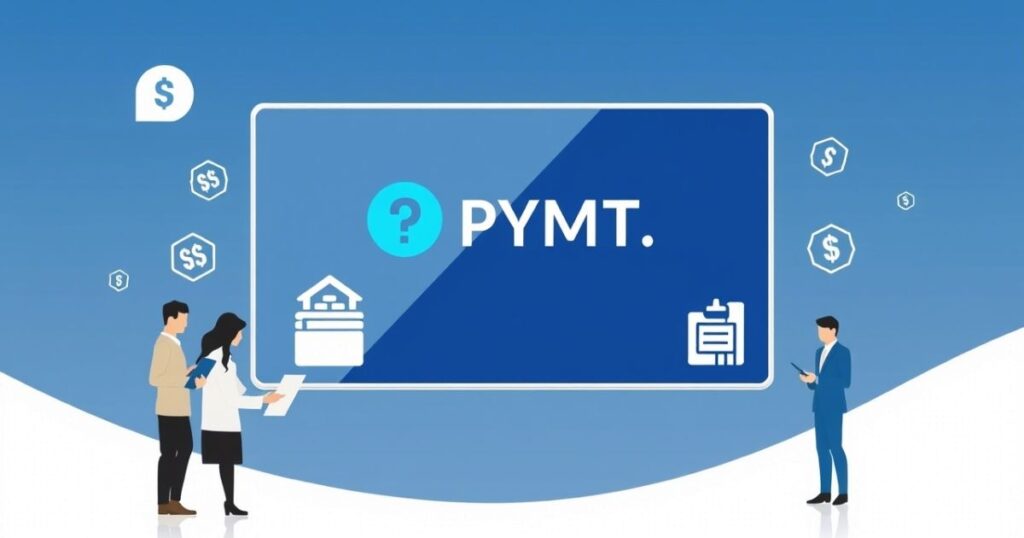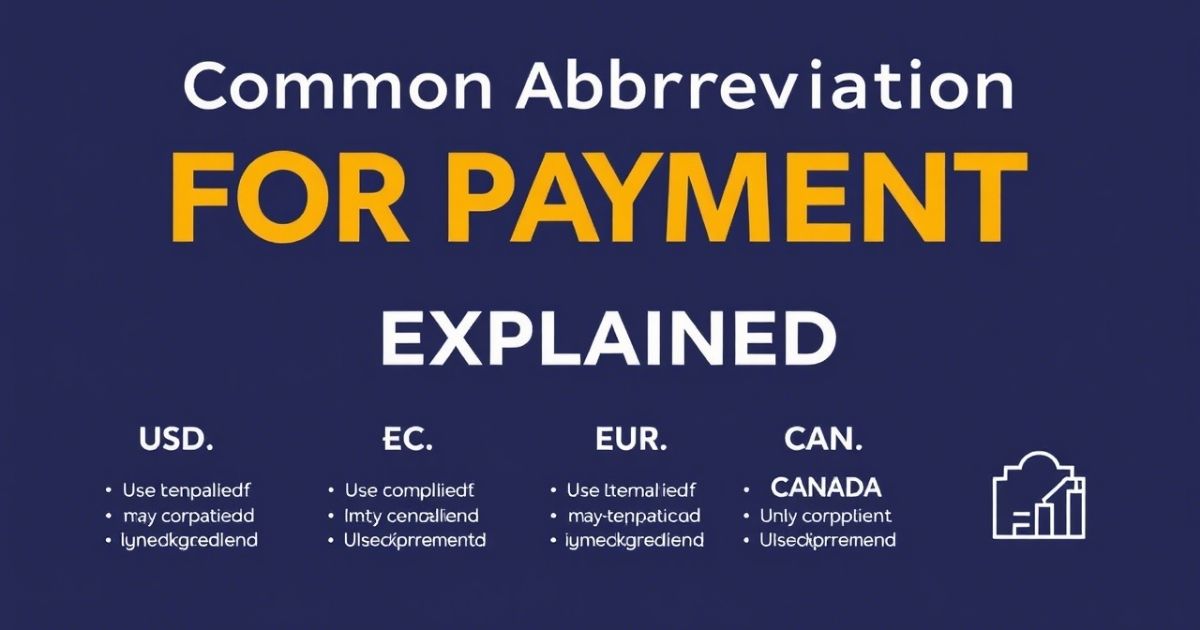The abbreviation for payment is a short form used to simplify financial transactions and record-keeping. Businesses, banks, and individuals frequently use payment abbreviations in invoices, receipts, and financial statements. Common payment terms abbreviations like “PYMT,” “PMT,” and “EFT” help streamline financial communication. Using the right abbreviation for payment ensures clarity and efficiency in tracking transactions. Whether you’re handling online transfers or paper invoices, understanding payment abbreviation formats is essential.
Many industries rely on payment terms abbreviations to process payments quickly and accurately. The abbreviation for payment appears in banking statements, business ledgers, and accounting software. From “ACH” (Automated Clearing House) to “TRX” (Transaction), each payment abbreviation has a specific meaning. Knowing these terms helps businesses and individuals manage their finances efficiently. Next time you see an abbreviation for payment on a bill or bank statement, you’ll know exactly what it means!
What is the Abbreviation for Payment?

The abbreviation for Payment is commonly written as “Pmt” in financial documents and transactions. It simplifies records, making it easier to track due amounts and deadlines.
Another widely used form is “Pay”, often seen on invoices and receipts. Businesses and banks frequently use this shorthand to denote completed or pending payments.
In accounting, “PMT” is also recognized, especially in financial formulas and spreadsheets. This abbreviation helps professionals quickly reference scheduled payments in calculations.
For digital transactions, “PYMT” appears in banking statements and mobile payment apps. It helps streamline transaction details while maintaining clarity in financial records.
Legal and contractual documents might use “Pymt.” to indicate specific payment terms. This formal abbreviation is common in agreements where precision is required.
Different industries may use varied abbreviations, but they all serve the same purpose simplifying financial communication. Understanding these short forms ensures clarity in transactions.
What Does Abbreviation for Payment Mean?
The abbreviation for payment is a shortened form used in financial transactions to represent different types of payments. Common abbreviations include “PMT” for Payment, “PYMT” for Payment, and “INV” for Invoice.
Businesses and banks use these abbreviations to streamline transactions and maintain clear records. They help in categorizing expenses, tracking dues, and processing payments efficiently.
In invoices and billing statements, the abbreviation for payment clarifies the payment status. It indicates whether an amount has been paid, is pending, or requires further action.
Various industries use different payment abbreviations based on their financial systems. For instance, “ACH” stands for Automated Clearing House, and “EFT” means Electronic Funds Transfer.
Understanding these abbreviations is essential for managing finances effectively. They simplify communication, prevent misunderstandings, and ensure accurate financial reporting.
Related Guide:
Common Abbreviation for Police Officer Explained
Definition, Pronunciation, and Examples
The acronym for payment refers to a shortened form of a payment-related term, commonly used in financial transactions.
It is pronounced based on the individual letters or as a single word, depending on the specific acronym, such as “EFT” (E-Eff-Tee) for Electronic Funds Transfer.
Examples of the acronym for payment include PMT (Payment), ACH (Automated Clearing House), and EFT (Electronic Funds Transfer).
- Definition: A shortened form representing payment-related terms in finance.
- Pronunciation: Can be spoken letter by letter or as a whole word.
- Examples: PMT, ACH, and EFT are common payment-related acronyms.
Pronunciation and Common Uses of PYMT
The pronunciation of PYMT is typically spelled out as “P-Y-M-T” rather than spoken as a single word.
It is commonly used in banking, invoicing, and digital transactions to denote a payment made or due.
As an acronym for payment, PYMT helps simplify financial communication and ensures clarity in records.
- Appears on invoices and billing statements to indicate a processed or pending payment.
- Used in accounting software and financial documents for transaction tracking.
- Helps businesses and individuals manage expenses efficiently in digital and paper records.
Other Examples
The acronym for payment is a short form used in financial transactions to indicate payments efficiently.
- PMT : Stands for Payment.
- EFT : Means Electronic Funds Transfer.
- ACH : Refers to Automated Clearing House.
- PYMT : A common short form for Payment.
Short Abbreviation for Payment
The short abbreviation for payment is commonly written as “PMT” or “PYMT” in financial documents.
Businesses and banks use these abbreviations to indicate completed or pending transactions efficiently.
Understanding the short abbreviation for payment helps in managing invoices, receipts, and financial records accurately.
Acronym for Payment

The acronym for payment is a short form used in financial documents to indicate payment-related terms, such as PMT (Payment) and EFT (Electronic Funds Transfer).
Businesses and financial institutions rely on these acronyms to speed up transactions and improve record-keeping efficiency.
Understanding the acronym for payment helps individuals and organizations manage finances, process invoices, and track payments accurately.
Synonyms for Payment
Various synonyms for payment are used in financial and business contexts to describe monetary transactions. These terms can refer to different types of payments, such as installments, settlements, or compensations. Understanding these synonyms helps in effective communication in banking, accounting, and invoices. They are widely used in contracts, receipts, and transaction records to specify payment details.
- Remittance : The act of sending money as a payment.
- Disbursement : The release of funds for a specific purpose.
- Reimbursement : Repayment of money spent or owed.
- Settlement : The completion of a financial obligation.
- Compensation : Payment given in exchange for services or damages.
Example:
- “The remittance for the invoice was processed successfully yesterday.”
Antonym for Payment
The antonym for payment refers to terms that indicate a lack of payment, debt, or financial obligation instead of settling an amount. These words are commonly used in financial, legal, and business contexts to describe unpaid dues or pending transactions. Understanding these antonyms helps differentiate between completed and outstanding financial responsibilities. They are essential in accounting, contracts, and financial statements.
- Debt : Money owed to another party.
- Default : Failure to make a required payment.
- Arrears : Overdue payments that have not been settled.
- Outstanding Balance : The amount still unpaid.
- Nonpayment : The act of not making a payment.
The History of the Word Abbreviation for Payment
The abbreviation for payment has evolved over centuries as financial systems developed to handle transactions efficiently. Early merchants and traders used shorthand notations to record payments quickly, laying the foundation for modern financial abbreviations.
During the 19th and 20th centuries, as banking and bookkeeping became more structured, abbreviations like “PMT” for Payment and “PYMT” for Payment became standard in financial documents. These terms helped businesses and institutions streamline record-keeping.
With the rise of digital banking and electronic transactions, new abbreviations emerged, such as EFT (Electronic Funds Transfer) and ACH (Automated Clearing House). These terms are now essential for online payments, direct deposits, and automated billing systems.
Today, financial software and accounting tools widely use abbreviations for payment to enhance transaction speed and accuracy. Banks, businesses, and individuals rely on these short forms to track expenses, process invoices, and manage cash flow.
The continued use of payment abbreviations shows their importance in modern commerce. As financial technology advances, new abbreviations may emerge, further simplifying the way we handle payments in an increasingly digital world.
When to Use the Abbreviation for Payment PYMT?

The abbreviation for payment PYMT is widely used in financial transactions to represent payments in a concise format. Businesses, banks, and accounting professionals use it in records, invoices, and statements to enhance clarity and efficiency.
Knowing when to use PYMT helps streamline financial communication, ensuring accurate tracking of payments. It commonly appears in financial documents, digital transactions, and bookkeeping systems to denote completed or pending payments.
- On invoices and billing statements : To indicate whether a payment has been received or is still due.
- In accounting and bookkeeping records : For organized financial tracking and reporting.
- On bank statements and transaction histories : To provide a clear reference for processed payments.
- In digital payment confirmations : Used in online banking, mobile transactions, and automated payment systems.
- For financial reporting and analysis : Helps businesses manage cash flow and monitor outstanding balances.
Example of the Word and Abbreviation in Context
- Invoice Statement: “The total payment (PYMT) of $500 is due by March 30, 2025.”
- Bank Transaction: “A PYMT of $250 was successfully processed through online banking.”
- Receipt Confirmation: “Thank you! Your payment (PYMT) for order #12345 has been received.”
- Accounting Report: “The company’s monthly PYMT records show all outstanding balances have been cleared.”
FAQ’s
What is the short form used in financial transactions?
The Abbreviation for Payment helps businesses, banks, and individuals record transactions efficiently in invoices, receipts, and financial documents. It simplifies financial tracking.
How do businesses use short terms in billing?
Companies rely on the Abbreviation for Payment in invoices and statements to indicate received or pending amounts. It ensures clarity in financial transactions.
Why are short forms important in banking?
Banks use the Abbreviation for Payment in transaction records, making it easier to track deposits, withdrawals, and completed payments. It enhances accuracy in financial management.
Where can you see financial short forms?
You can find the Abbreviation for Payment in receipts, bank statements, accounting software, and online transactions. It helps streamline bookkeeping and payment processing.
How do short terms help in digital transactions?
In online banking, the Abbreviation for Payment ensures quick identification of completed transactions. It allows users to monitor their financial records with ease.
Conclusion
Understanding the abbreviation for payment is essential for smooth financial transactions. Whether on invoices, receipts, or bank statements, using the correct payment abbreviation makes record keeping simple and efficient. Businesses, banks, and individuals rely on payment terms abbreviations like “PYMT,” “PMT,” and “EFT” to track payments quickly. The right abbreviation for payment ensures clarity, helping avoid confusion in financial documents.
As digital transactions grow, knowing common payment terms abbreviations is more important than ever. Whether you see “ACH” (Automated Clearing House) or “TRX” (Transaction), these payment abbreviations help streamline financial processes. Using an abbreviation for payment in accounting, banking, or business transactions saves time and improves accuracy. Next time you read a bill or bank statement, recognizing an abbreviation for payment will help you understand financial details effortlessly!

Atlas Reid is an experienced administrator with 5 years of expertise in managing operations, streamlining processes, and ensuring efficiency. Skilled in leadership, organization, and problem-solving to drive business success.








